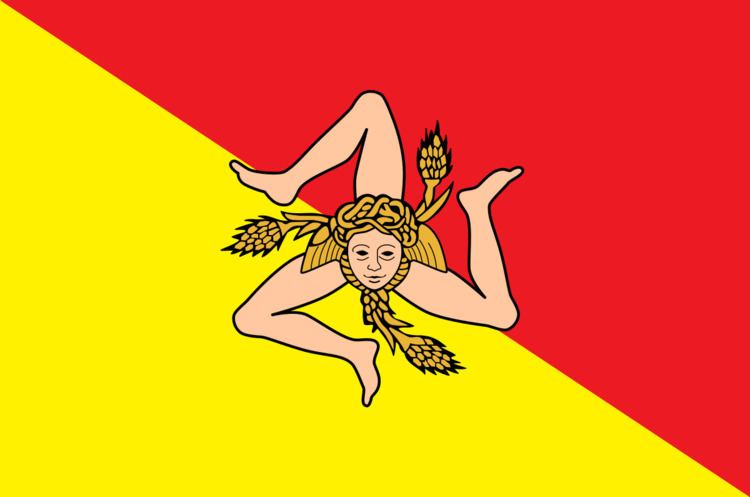 | ||
The word Trinacria means triquetra and refers to the shape of the island of Sicily (“Sicilia” in Italian), the largest island in the Mediterranean. Sicily was known by the Romans as Trinacrium, meaning “star with three points”. The Trinacria symbol is the head of Medusa (a gorgon with a head of snakes), surrounded by three bent running legs, and three stalks of wheat. Due to the island's distinct triangular shape, the symbol has also been adopted by the Sicilian government and is located on the center of Sicily's flag. The Trinacria's shape is often referred to as a triskelion; this shape can be found in many places among the general Mediterranean Basin region and in many European countries like France, Sicily, Crete, Greece, the North African coast, and the Isle of Man. The triskelions found in these locations have all dated back to after the eighth century BC.
Contents
Representation of the Trinacria
The three bent running legs represent the three capes of Sicily, Peloro (Punta del Faro, Tip of Faro, Messina: North-East), Passero (Syracuse: South), and Lilibeo(Cape Boeo, Marsala: West), which also creates the three points of the triangle. Native Sicilians, left breathless by the beauty of Sicily’s shores, likened and compared them to those of a woman. The three ears of wheat, surrounding the head of Medusa, represent the fertility of the land of Sicily. The Romans would celebrate the extreme fertility of the island, during a period when Sicily was the granary of the Roman empire. The center Medusa head in the middle of the Trinacria implies the protection of the island by the goddess Athena, the patron goddess of Sicily. In early mythology, when Medusa was renowned as Athena’s destructive aspect, slain and beheaded by Perseus, the Medusa head was accessorized in the center of Athena's shield.
History of the Trinacria
The Trinacria came to be on the Sicilian flag in 1943 during World War II when Andrea Finocchiaro Aprile led an independence movement, in collaboration with the allies. Their plan was to help Sicily become independent and form a free Republic. The separatist behind the movement used a yellow and red flag with the trinacria in the center of it. When World War II ended, Sicily was recognized as an autonomous region in the Italian republic. Although the Trinacria was recognized worldwide on Sicily's flag in World War II, the distinct symbol made its first debut on syracusan coins dating back to the fourth century BC.
Story of Colapesce
Colapesce, a boy from Messina, loved staying in the water and would spend most of his days swimming. He resided in the water for so long that he slowly started to gain fish (Pesce) like characteristics, such as being able to swim underwater for long periods of time without needing air. When King Frederick II found out about the young boy and his talent, he sailed to visit him. When he met him, he tested the boys abilities by throwing his possessions overboard for the boy to retrieve. He gradually began diving deeper into the water, always returning with the king’s possessions. However, when the boy was asked to retrieve the kings crown, he noticed a peculiar sight under the water. He saw the island of Sicily being held and supported by three columns, one intact, the second slightly chipped and scratched, and the third was crumbling away, making Colapesce uneasy at the sight of it. When King Frederick asked the boy to retrieve his ring, Colapesce was worried he might not come back. Eventually he decide to go but asked for a handful of lentils, saying “If you see the lentils float to the surface then I will not be coming back.” After waiting a few days for Colapesce to return, the king looked into the water and saw his ring and lentils float to the surface. He then knew that Colapesce had chosen to take the broken column upon his shoulders to support Sicily. Sicilians claim that when the island shakes from earthquakes it is Colapesce, moving the island on his shoulder because he is tired.
Trinacria may also refer to
